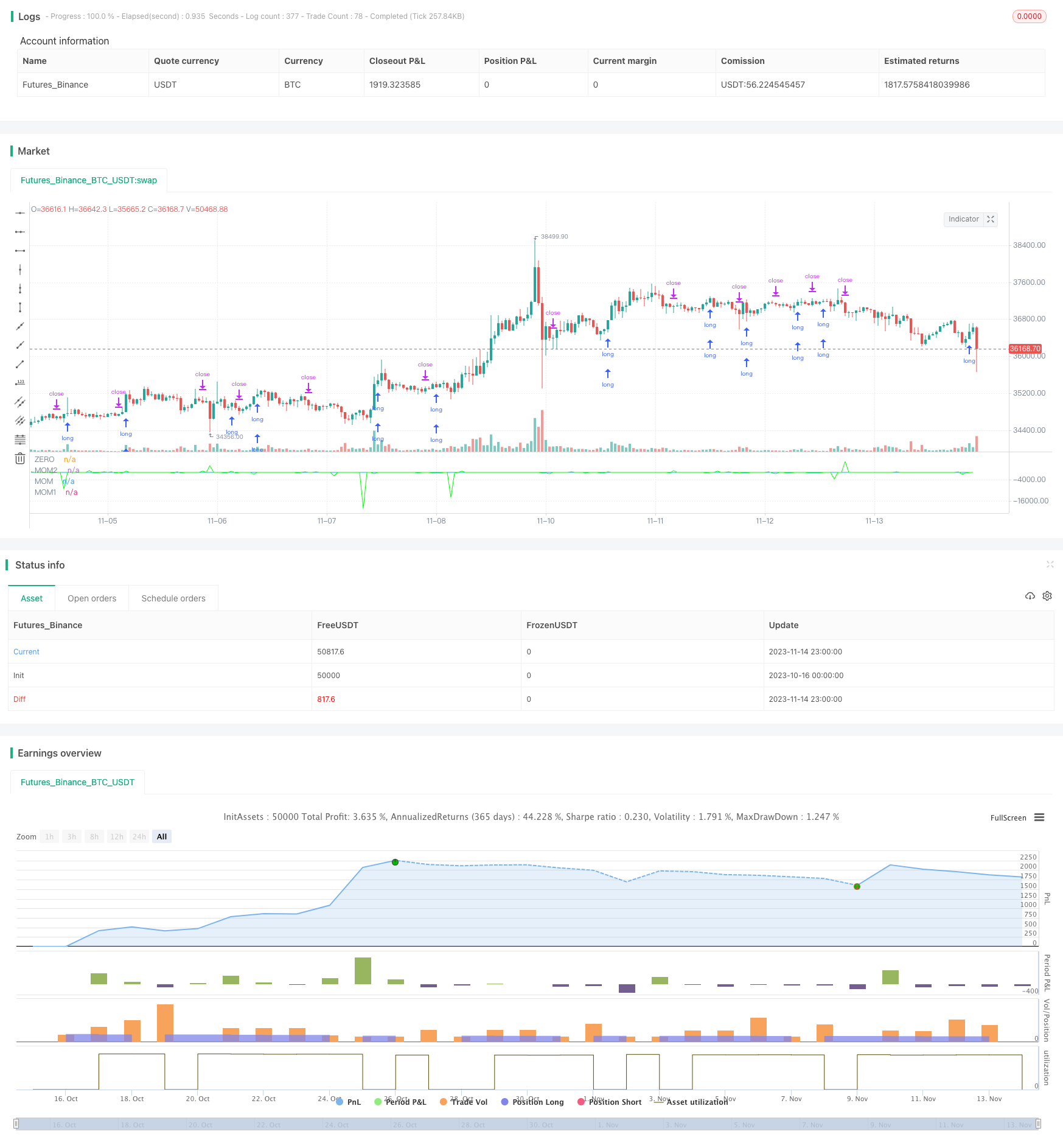
概述
该策略是一种双动量指标突破策略。它使用两个不同参数设置的动量指标,在两个动量指标都突破零轴时产生交易信号。该策略只做多头 entries,空头仅用于平仓。
策略原理
代码首先设置策略属性,如委托模式、手续费模式等。然后它计算两个动量指标:
// Momentum settings
i_len = input(defval = 12, title = "Length", minval = 1)
i_src = input(defval = close, title = "Source")
i_percent = input(defval = true, title = "Percent?")
i_mom = input(defval = "MOM2", title = "MOM Choice", options = ["MOM1", "MOM2"])
// Momentum code
mom0 = momentum(i_src, i_len, i_percent)
mom1 = momentum(mom0, 1, i_percent)
mom2 = momentum(i_src, 1, i_percent)
momX = mom1
if i_mom == "MOM2"
momX := mom2
mom0是基础动量指标,长度为i_len,数据源为i_src,是否计算百分比由i_percent决定。
mom1是以mom0为数据源,长度为1的动量指标。
mom2是以原始数据i_src为源,长度为1的动量指标。
最终使用的动量指标momX默认为mom1,也可以选择mom2。
当mom0和momX同时超过0轴时,做多;当mom0和momX同时低于0轴时,平仓。
策略优势
使用双动量指标结合不同参数设置,可以提高交易信号的可靠性,双重确认降低了假信号。
只做多头entries,空头仅用于平仓,可以降低交易频率,减少交易成本。
动量指标参数可以调整,适应不同市场环境。
代码结构清晰,容易理解和修改。
加入了交易消息设置,可以结合自动交易系统使用。
策略风险
双动量指标虽然可以减少假信号,但也可能错过较弱的趋势信号。
仅做多头交易,可能错过空头交易机会。
动量指标参数设置不当可能导致过于频繁或过于迟缓的交易。
回测数据不充分可能导致参数过拟合。
双重确认虽降低假信号但无法完全避免,实盘交易时仍需关注突破有效性。
策略优化方向
可以测试不同长度以及是否计算百分比的参数组合,找出最佳参数。
可以考虑在趋势确认后,加入空头交易信号,以捕捉更多交易机会。
可以测试不同的动量指标计算方式,如ROC,RSI等,寻找更好的效果。
可以结合趋势过滤,避免在震荡行情中交易。
可以优化止损策略,在利润最大化的同时控制风险。
总结
本策略是一个典型的双动量指标突破策略。它使用双重确认降低假信号,只做多头进入以减少交易频率。该策略优点是简单明了,容易实现,在参数优化和风险控制时有很大的改进空间。整体来说,本策略作为动量突破策略的基础框架是可行的,但需要针对具体市场进行优化调整,才能在实盘中稳定盈利。
/*backtest
start: 2023-10-16 00:00:00
end: 2023-11-15 00:00:00
period: 1h
basePeriod: 15m
exchanges: [{"eid":"Futures_Binance","currency":"BTC_USDT"}]
*/
//@version=4
strategy("Momentum Long Strategy", overlay = false, precision = 2, initial_capital = 10000, default_qty_value = 10000, default_qty_type = strategy.cash, commission_type = strategy.commission.percent, commission_value = 0, calc_on_every_tick = true)
// There will be no short entries, only exits from long.
strategy.risk.allow_entry_in(strategy.direction.long)
// Calculate start/end date and time condition
startDate = input(timestamp("2021-01-02T00:00:00"), title = "Start Date", type = input.time)
finishDate = input(timestamp("2021-12-31T00:00:00"), title = "End Date",type = input.time)
time_cond =true
// Momentum settings
i_len = input(defval = 12, title = "Length", minval = 1)
i_src = input(defval = close, title = "Source")
i_percent = input(defval = true, title = "Percent?")
i_mom = input(defval = "MOM2", title = "MOM Choice", options = ["MOM1", "MOM2"])
// Messages for buy and sell
message_buy = input("{{strategy.order.alert_message}}", title="Buy message")
message_sell = input("{{strategy.order.alert_message}}", title="Sell message")
// Momentum code
momentum(seria, length, percent) =>
_mom = percent ? ( (seria / seria[length]) - 1) * 100 : seria - seria[length]
_mom
mom0 = momentum(i_src, i_len, i_percent)
mom1 = momentum(mom0, 1, i_percent)
mom2 = momentum(i_src, 1, i_percent)
momX = mom1
if i_mom == "MOM2"
momX := mom2
// Strategy Alerts
if (mom0 > 0 and momX > 0 and time_cond)
strategy.entry("MomLE", strategy.long, stop = high + syminfo.mintick, comment = "MomLE", alert_message = message_buy)
else
strategy.cancel("MomLE")
if (mom0 < 0 and momX < 0 and time_cond)
strategy.entry("MomExit", strategy.short, stop = low - syminfo.mintick, comment = "MomSE", alert_message = message_sell)
else
strategy.cancel("MomExit")
// Plotting
plot(0, color = #5d606b, title = "ZERO")
plot(mom0, color = #00bcd4, title = "MOM")
plot(mom1, color = #00FF00, title = "MOM1", display = display.none)
plot(mom2, color = #00FF00, title = "MOM2")